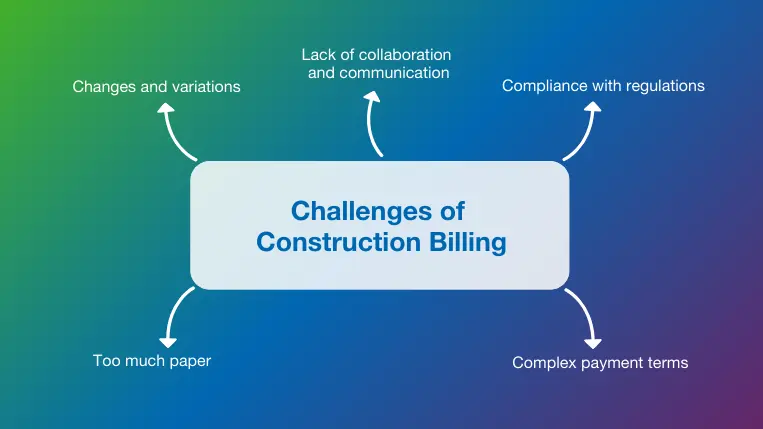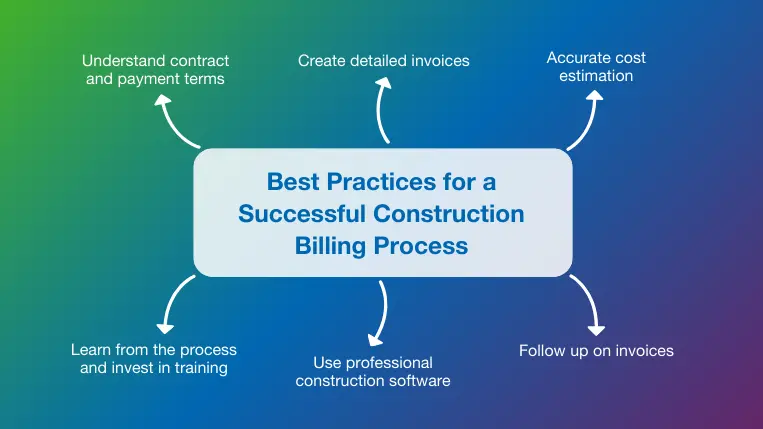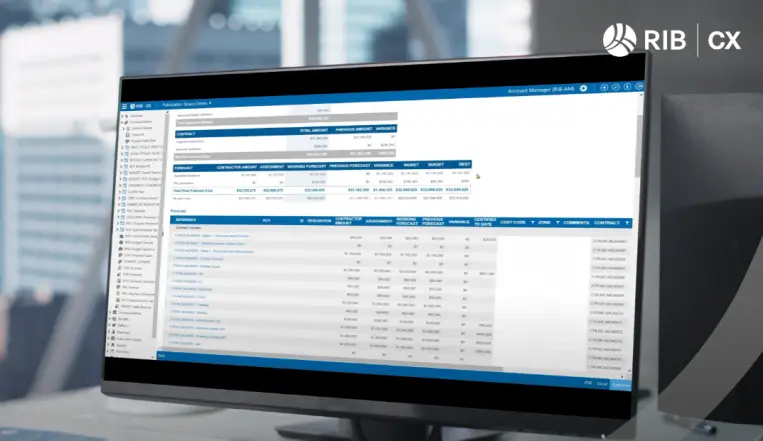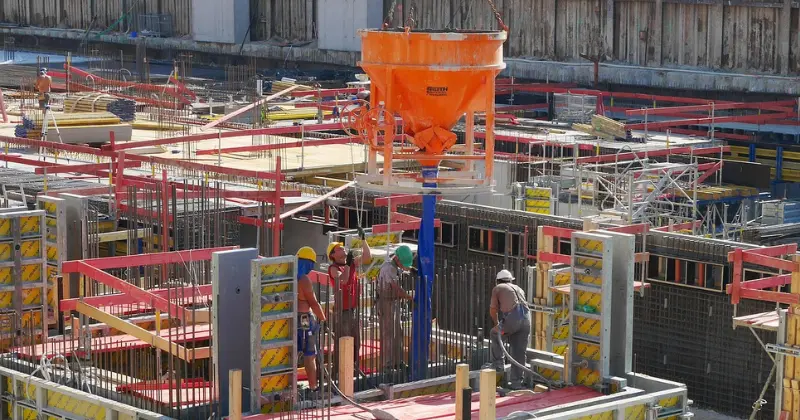10 mins read
How to Achieve Construction Billing Success: Common Methods and Best Practices

Construction billing is a fundamental aspect of contractor management. It defines the methods by which contractors will be paid for their work and at what project stage. Understanding the types of billing methods, the requirements of each, and the pros and cons can make a significant difference in the success of a project and the efficiency of the relationship between the owner and the contractor.
In this RIB guide, we will define construction billing and key methods, explain the common challenges companies face, and provide tips and best practices for overcoming them and achieving success with modern software.
Let’s dive in with a definition!
What is Construction Billing?
Construction billing is the process of invoicing a client for the work carried out in a construction project, including materials, labor, equipment, and other expenses. The payment terms and other relevant requirements are defined based on the chosen billing method.
An efficient billing process supported by digital construction technologies ensures a healthy and trusting relationship between the client and the contractor or construction company, as all the payment terms and conditions are clearly stated. It also helps maintain the project’s financial efficiency by accurately recording expenses and project costs. Paired with that, a good billing system also provides legal protection to both parties. In case of any disputes, invoices can be used as evidence in legal proceedings.
Construction Billing Methods
There are different types of billing methods depending on the project’s scope, the client’s preferences, and the contractor’s financial capabilities. Understanding each type can help you make the right decision to ensure smooth operations and communication. Let’s discuss the most common ones below.
- Lump Sum Billing: Also known as fixed price billing, this method is used when the contractor and the owner agree on a set price for all the work. This means the initial price should remain the same until the end unless there are change orders during the project. Contractors benefit from this method because it allows them to control their profitability. However, it can backfire if a lot of changes in materials or labor hours occur, as the contractor needs to account for these extra costs. For that reason, detailed and accurate construction cost estimates are fundamental in lump sum contracts.
- Cost-Plus Billing: In this billing method, the contractor gets paid for all expenses plus a percentage or fixed fee to cover profit. It is mainly used in projects where the costs and scope are unclear, making it less risky for the contractor and offering transparency to the owner regarding costs. The big disadvantage of this method is the amount of paperwork that needs to be generated from the owner and the contractor’s side, as all expenses need to be detailed as they happen.
- Time and Materials Billing: As its name suggests, this billing method charges the owner for labor hours and the cost of materials. The contractor’s profit is included in the price of the labor hour. Like the cost-plus method, time and materials contracts also don’t have a clear scope, which can lead to costs escalating beyond the initial estimates. Therefore, it is mainly used in small projects.
- Guaranteed Maximum Price (GMP): GMP is when the contractor agrees to carry out the work for a fixed price but with an upper-cost limit. It is considered the middle ground between lump sum and time and materials billings because the contractor cannot keep the additional profits if the projects are cheaper than the fixed amount. Therefore, it is more interesting for the owner. Owners are also keen to choose this method because the risks are passed on to the contractor, who is pressured to finish fast and without mistakes to avoid extra costs.
- Unit Pricing Billing: As its name suggests, the unit price billing charges the owner for each unit of work completed, which can be per square foot, per hour, or per item. Each unit price includes labor, materials, and equipment costs plus profit. The method is used in large and complex projects where the contractor divides the work into sections to keep pricing as detailed as possible. It is considered one of the best billing methods as expenses are made as needed instead of bulking. It also provides clarity and transparency for all expenses, avoiding misunderstandings or disputes.
- Progress Billing: This method involves the contractor billing the owner after completing a milestone, project phase, or specific task. It is an excellent method for contractors because it ensures a positive cash flow throughout the project and gives the owner visibility into its progress. Investing in a professional construction reporting system to track progress is a good practice for this billing type.
- Retention Billing: Finally, retainage billing is when the owner withholds a percentage of the total contract value until the project is completed. The remaining payment percentage is paid to the contractor as agreed-upon milestones are achieved. This assures the owner that the contractor will finish the work as expected.
Challenges of Construction Billing

Accounting and contract management are very complex processes that are not free of challenges. Being aware of these challenges and how to overcome them can reduce errors, save money, and improve communication in construction projects.
Changes and variations
Variations and change orders are almost unavoidable in building projects. They present a challenge in billing because they require detailed tracking of the additional work, and accurate cost adjustments, not to mention all the administrative work that comes with getting the owner’s permission to implement the change. Therefore, to manage this challenge successfully, investing in online construction billing software that automatically tracks and records changes is a great practice. These solutions handle all documentation in a centralized location, ensuring no critical information is ignored or mishandled.
Lack of collaboration and communication
Communication and collaboration in construction projects have long been challenges for the industry. The billing process is one of the many areas that can suffer the consequences of poor communication, such as poorly written conditions or missing or inaccurate documentation that leads to payment delays or, worst case, legal disputes.
To avoid being affected by communication issues, it is important to ensure that the project’s documentation is written by a professional and that any changes or variations are left in writing to avoid misunderstandings down the road. Supporting yourself with professional construction collaboration software can also ensure the document management process is more automated and efficient.
Compliance with regulations
Like many other processes in the industry, construction billing must adhere to various legal regulations and standards. This can often present a challenge as some of these regulations can be overlooked and cause issues later. Therefore, it is recommended that effort and resources be put into ensuring the contract is entirely legal. This also requires detailed tracking of financial data.
Complex payment terms
As we saw with all the construction billing methods, sometimes the payment terms are complex, making it challenging to manage them accurately, especially when dealing with multiple projects simultaneously. For example, in lump sum billing, it is hard for contractors to adjust billing when change orders occur, especially when careful tracking of all changes has not been done. That is why contractors are starting to charge unit rates, as changes are more accessible to organize and invoices to recalculate. Regardless, efficiently tracking changes with the right software and tools can eliminate these challenges and ensure a smooth billing process for all methods.
Too much paper
Many organizations in the building industry still rely on paper or manual billing processes. This is a huge mistake, as paper-based or manual documentation is highly prone to error, time-consuming, and at high risk of getting lost. Plus, ensuring everyone is on the same page regarding changes is almost impossible when working with paper.
Best Practices for a Successful Construction Billing Process

As you just learned, the project billing process is not free of challenges. Fortunately, following industry best practices can help overcome these potential hardships and ensure you go into the process prepared and informed. Remember, billing success depends on your attention to detail, clear communication, and the right technology to support it.
Understand contract and payment terms
This might sound obvious, but many construction companies end up in legal disputes because they sign a contract without genuinely understanding its terms and conditions. We recommend that before you sign anything, you make sure to read the entire agreement and understand the billing method so you can adapt your record-keeping and financial strategies to it. Ensuring the contract is as detailed as possible is also important to avoid misunderstandings.
Create detailed invoices
It is essential to keep your invoices as detailed as possible to avoid billing disputes and payment delays. A well-made invoice should include detailed records of the money spent on labor, materials, equipment, and other expenses, and the information should be outlined clearly and easily to prevent disputes or misunderstandings. Relying on digital tools to generate invoices is the best way to avoid the error-prone nature of manual invoicing.
Accurate cost estimation
Accurate cost estimation is critical for precise billing. Your estimates should detail all potential expenses, including labor, materials, equipment, and subcontractor fees, to truly reflect the project’s costs. Supporting yourself with construction estimating software like RIB Candy can help you digitalize and automate the estimating process to ensure accurate cost management and billing. Our platform automatically updates the estimates to reflect any changes, providing a precise expense record that aids project profitability.
Follow up on invoices
Payment issues can happen for several reasons, including the owner running out of money to pay or forgetting about it. Whatever the case, it is excellent practice to follow up on your invoices to remind the client that the payment date is approaching. Professional construction billing software can help you keep track of due dates and determine the best time to approach the client for a reminder.
Use professional construction software
If you are struggling with your construction billing process, it is probably because you lack the support of the right technology. Investing in a web-based construction management software like RIB CX can positively impact your billing strategies and provide your company with a substantial competitive advantage. Our platform allows you to manage multiple contracts at the same time with innovative features for accurate estimating and budgeting, cost break downs, and automated payment schedules, all in an online environment that allows for enhanced communication and collaboration.
Learn from the process and invest in training
As you’ve learned throughout this post, the construction billing process is complex and requires thorough communication, collaboration, and attention to detail to ensure successful completion. Implementing a continuous improvement mindset into the process can help you spot improvement opportunities to make the process more efficient every time. This also involves investing in training instances to keep your team up to date with regulations and industry best practices. Professional construction analytics software can help you track the success of your efforts through interactive dashboards containing real-time insights to inform your strategies.
Final Thoughts
Efficient billing is a critical aspect of successful construction project management. As billing methods become more complex, knowing the common challenges and industry best practices can make the process faster and more cost-effective while securing healthy work relationships between owners and contractors. Ensuring you choose the billing method that best fits the project’s scope and client needs is also fundamental to avoiding issues.
With the support of the right technology, construction billing does not have to be tedious and time-consuming. The right solution can simplify billing by automating manual tasks and eliminating error-prone processes, leaving you enough time to focus on completing the project.
At RIB Software, we are committed to providing modern construction companies with the best solutions tailored to their needs. Our construction management software, RIB CX, offers various advanced features to manage your contracts efficiently from start to finish. If you are ready to experience the power of modern construction technology, get a demo for RIB CX today!

Most Recent
10 mins read
29 mins read
27 mins read
24 mins read
Blog Categories

Ebook











